Business Communication Report: Information Analysis, Luton College
VerifiedAdded on 2020/07/22
|16
|3521
|24
Report
AI Summary
This report provides a comprehensive analysis of business communication, focusing on different types of business information, their sources, and purposes. It examines verbal, written, multimedia, and web-based information and their applications within a business context. The report evaluates the appropriateness of business information in making strategic decisions, using Tesco as a case study. It also explores internal and external corporate communications, including verbal and written formats, as well as marketing strategies. Furthermore, the report delves into the legal, ethical, and operational issues related to the use of business information, covering topics such as data security and ethical considerations. The report concludes by analyzing electronic and non-electronic methods of communicating business information, offering a complete overview of the subject matter.
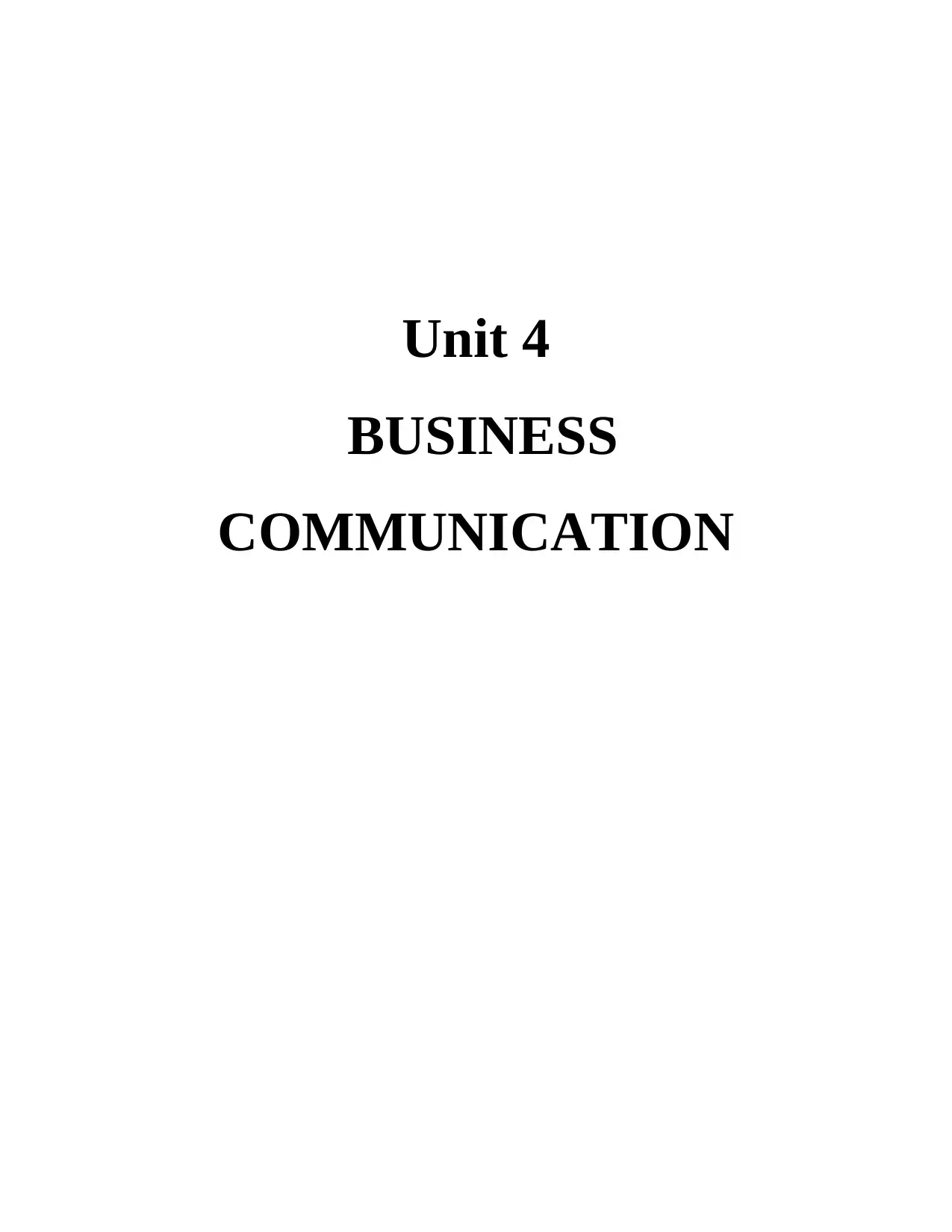
Unit 4
BUSINESS
COMMUNICATION
BUSINESS
COMMUNICATION
Paraphrase This Document
Need a fresh take? Get an instant paraphrase of this document with our AI Paraphraser
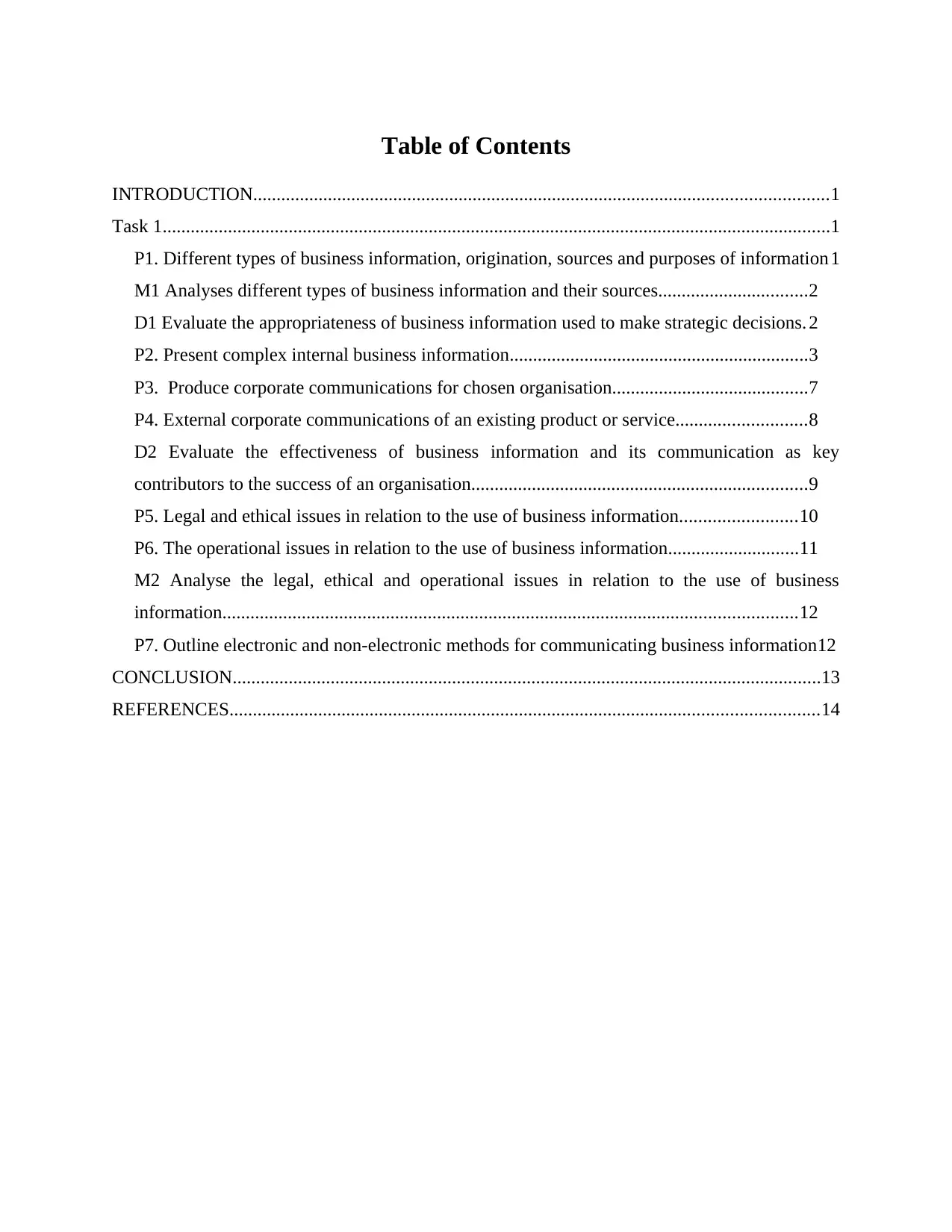
Table of Contents
INTRODUCTION...........................................................................................................................1
Task 1...............................................................................................................................................1
P1. Different types of business information, origination, sources and purposes of information 1
M1 Analyses different types of business information and their sources................................2
D1 Evaluate the appropriateness of business information used to make strategic decisions. 2
P2. Present complex internal business information................................................................3
P3. Produce corporate communications for chosen organisation..........................................7
P4. External corporate communications of an existing product or service............................8
D2 Evaluate the effectiveness of business information and its communication as key
contributors to the success of an organisation........................................................................9
P5. Legal and ethical issues in relation to the use of business information.........................10
P6. The operational issues in relation to the use of business information............................11
M2 Analyse the legal, ethical and operational issues in relation to the use of business
information...........................................................................................................................12
P7. Outline electronic and non-electronic methods for communicating business information12
CONCLUSION..............................................................................................................................13
REFERENCES..............................................................................................................................14
INTRODUCTION...........................................................................................................................1
Task 1...............................................................................................................................................1
P1. Different types of business information, origination, sources and purposes of information 1
M1 Analyses different types of business information and their sources................................2
D1 Evaluate the appropriateness of business information used to make strategic decisions. 2
P2. Present complex internal business information................................................................3
P3. Produce corporate communications for chosen organisation..........................................7
P4. External corporate communications of an existing product or service............................8
D2 Evaluate the effectiveness of business information and its communication as key
contributors to the success of an organisation........................................................................9
P5. Legal and ethical issues in relation to the use of business information.........................10
P6. The operational issues in relation to the use of business information............................11
M2 Analyse the legal, ethical and operational issues in relation to the use of business
information...........................................................................................................................12
P7. Outline electronic and non-electronic methods for communicating business information12
CONCLUSION..............................................................................................................................13
REFERENCES..............................................................................................................................14
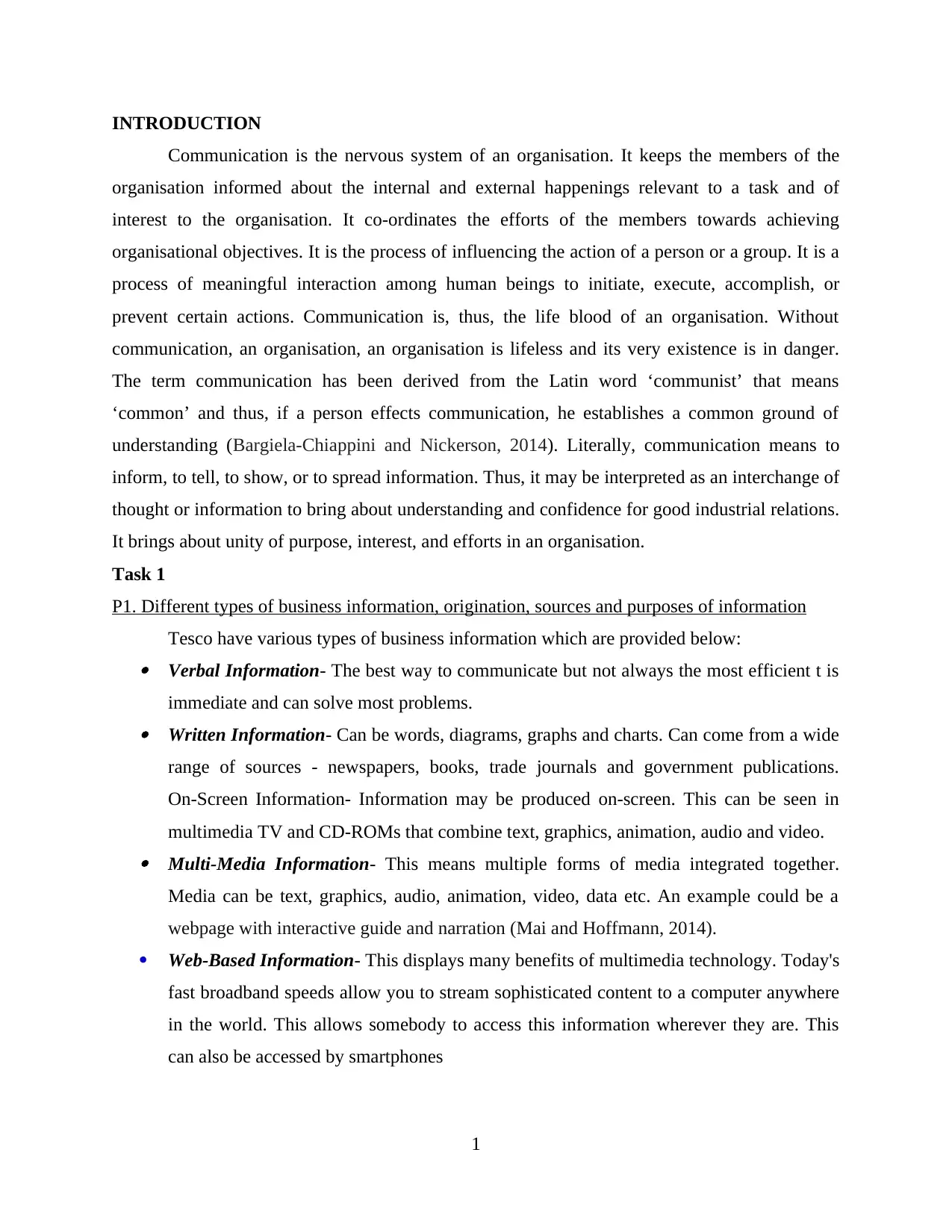
INTRODUCTION
Communication is the nervous system of an organisation. It keeps the members of the
organisation informed about the internal and external happenings relevant to a task and of
interest to the organisation. It co-ordinates the efforts of the members towards achieving
organisational objectives. It is the process of influencing the action of a person or a group. It is a
process of meaningful interaction among human beings to initiate, execute, accomplish, or
prevent certain actions. Communication is, thus, the life blood of an organisation. Without
communication, an organisation, an organisation is lifeless and its very existence is in danger.
The term communication has been derived from the Latin word ‘communist’ that means
‘common’ and thus, if a person effects communication, he establishes a common ground of
understanding (Bargiela-Chiappini and Nickerson, 2014). Literally, communication means to
inform, to tell, to show, or to spread information. Thus, it may be interpreted as an interchange of
thought or information to bring about understanding and confidence for good industrial relations.
It brings about unity of purpose, interest, and efforts in an organisation.
Task 1
P1. Different types of business information, origination, sources and purposes of information
Tesco have various types of business information which are provided below: Verbal Information- The best way to communicate but not always the most efficient t is
immediate and can solve most problems. Written Information- Can be words, diagrams, graphs and charts. Can come from a wide
range of sources - newspapers, books, trade journals and government publications.
On-Screen Information- Information may be produced on-screen. This can be seen in
multimedia TV and CD-ROMs that combine text, graphics, animation, audio and video. Multi-Media Information- This means multiple forms of media integrated together.
Media can be text, graphics, audio, animation, video, data etc. An example could be a
webpage with interactive guide and narration (Mai and Hoffmann, 2014).
Web-Based Information- This displays many benefits of multimedia technology. Today's
fast broadband speeds allow you to stream sophisticated content to a computer anywhere
in the world. This allows somebody to access this information wherever they are. This
can also be accessed by smartphones
1
Communication is the nervous system of an organisation. It keeps the members of the
organisation informed about the internal and external happenings relevant to a task and of
interest to the organisation. It co-ordinates the efforts of the members towards achieving
organisational objectives. It is the process of influencing the action of a person or a group. It is a
process of meaningful interaction among human beings to initiate, execute, accomplish, or
prevent certain actions. Communication is, thus, the life blood of an organisation. Without
communication, an organisation, an organisation is lifeless and its very existence is in danger.
The term communication has been derived from the Latin word ‘communist’ that means
‘common’ and thus, if a person effects communication, he establishes a common ground of
understanding (Bargiela-Chiappini and Nickerson, 2014). Literally, communication means to
inform, to tell, to show, or to spread information. Thus, it may be interpreted as an interchange of
thought or information to bring about understanding and confidence for good industrial relations.
It brings about unity of purpose, interest, and efforts in an organisation.
Task 1
P1. Different types of business information, origination, sources and purposes of information
Tesco have various types of business information which are provided below: Verbal Information- The best way to communicate but not always the most efficient t is
immediate and can solve most problems. Written Information- Can be words, diagrams, graphs and charts. Can come from a wide
range of sources - newspapers, books, trade journals and government publications.
On-Screen Information- Information may be produced on-screen. This can be seen in
multimedia TV and CD-ROMs that combine text, graphics, animation, audio and video. Multi-Media Information- This means multiple forms of media integrated together.
Media can be text, graphics, audio, animation, video, data etc. An example could be a
webpage with interactive guide and narration (Mai and Hoffmann, 2014).
Web-Based Information- This displays many benefits of multimedia technology. Today's
fast broadband speeds allow you to stream sophisticated content to a computer anywhere
in the world. This allows somebody to access this information wherever they are. This
can also be accessed by smartphones
1
⊘ This is a preview!⊘
Do you want full access?
Subscribe today to unlock all pages.

Trusted by 1+ million students worldwide
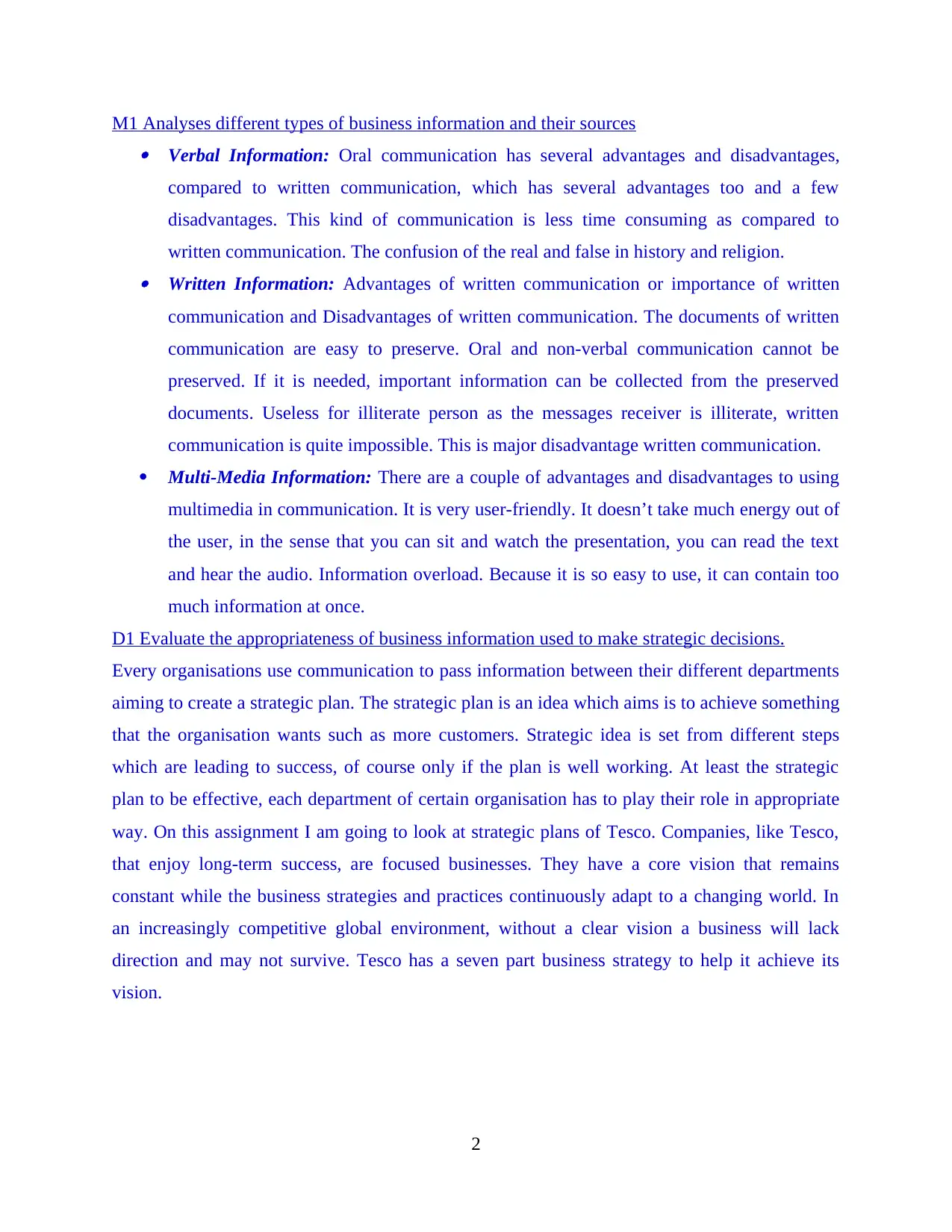
M1 Analyses different types of business information and their sources Verbal Information: Oral communication has several advantages and disadvantages,
compared to written communication, which has several advantages too and a few
disadvantages. This kind of communication is less time consuming as compared to
written communication. The confusion of the real and false in history and religion. Written Information: Advantages of written communication or importance of written
communication and Disadvantages of written communication. The documents of written
communication are easy to preserve. Oral and non-verbal communication cannot be
preserved. If it is needed, important information can be collected from the preserved
documents. Useless for illiterate person as the messages receiver is illiterate, written
communication is quite impossible. This is major disadvantage written communication.
Multi-Media Information: There are a couple of advantages and disadvantages to using
multimedia in communication. It is very user-friendly. It doesn’t take much energy out of
the user, in the sense that you can sit and watch the presentation, you can read the text
and hear the audio. Information overload. Because it is so easy to use, it can contain too
much information at once.
D1 Evaluate the appropriateness of business information used to make strategic decisions.
Every organisations use communication to pass information between their different departments
aiming to create a strategic plan. The strategic plan is an idea which aims is to achieve something
that the organisation wants such as more customers. Strategic idea is set from different steps
which are leading to success, of course only if the plan is well working. At least the strategic
plan to be effective, each department of certain organisation has to play their role in appropriate
way. On this assignment I am going to look at strategic plans of Tesco. Companies, like Tesco,
that enjoy long-term success, are focused businesses. They have a core vision that remains
constant while the business strategies and practices continuously adapt to a changing world. In
an increasingly competitive global environment, without a clear vision a business will lack
direction and may not survive. Tesco has a seven part business strategy to help it achieve its
vision.
2
compared to written communication, which has several advantages too and a few
disadvantages. This kind of communication is less time consuming as compared to
written communication. The confusion of the real and false in history and religion. Written Information: Advantages of written communication or importance of written
communication and Disadvantages of written communication. The documents of written
communication are easy to preserve. Oral and non-verbal communication cannot be
preserved. If it is needed, important information can be collected from the preserved
documents. Useless for illiterate person as the messages receiver is illiterate, written
communication is quite impossible. This is major disadvantage written communication.
Multi-Media Information: There are a couple of advantages and disadvantages to using
multimedia in communication. It is very user-friendly. It doesn’t take much energy out of
the user, in the sense that you can sit and watch the presentation, you can read the text
and hear the audio. Information overload. Because it is so easy to use, it can contain too
much information at once.
D1 Evaluate the appropriateness of business information used to make strategic decisions.
Every organisations use communication to pass information between their different departments
aiming to create a strategic plan. The strategic plan is an idea which aims is to achieve something
that the organisation wants such as more customers. Strategic idea is set from different steps
which are leading to success, of course only if the plan is well working. At least the strategic
plan to be effective, each department of certain organisation has to play their role in appropriate
way. On this assignment I am going to look at strategic plans of Tesco. Companies, like Tesco,
that enjoy long-term success, are focused businesses. They have a core vision that remains
constant while the business strategies and practices continuously adapt to a changing world. In
an increasingly competitive global environment, without a clear vision a business will lack
direction and may not survive. Tesco has a seven part business strategy to help it achieve its
vision.
2
Paraphrase This Document
Need a fresh take? Get an instant paraphrase of this document with our AI Paraphraser
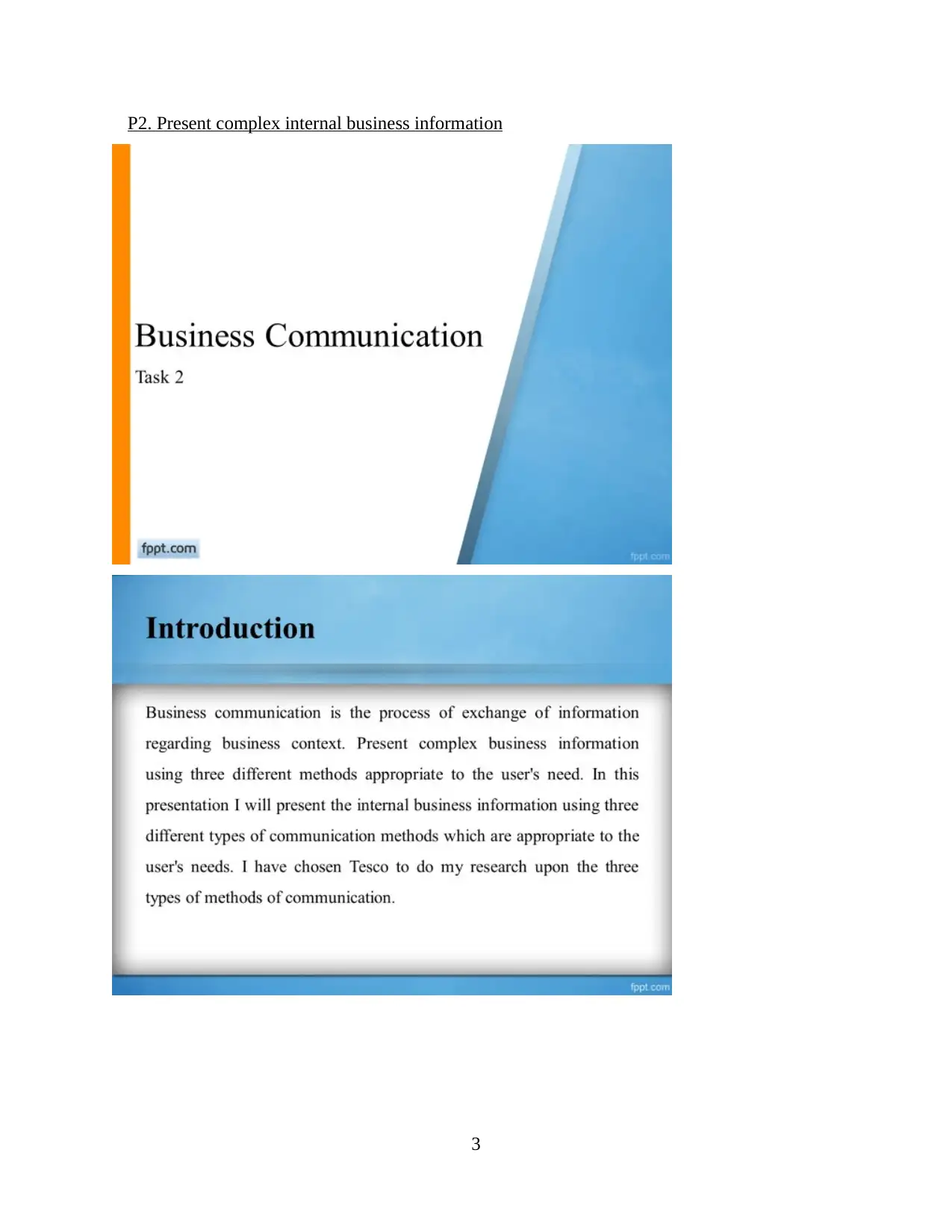
P2. Present complex internal business information
3
3
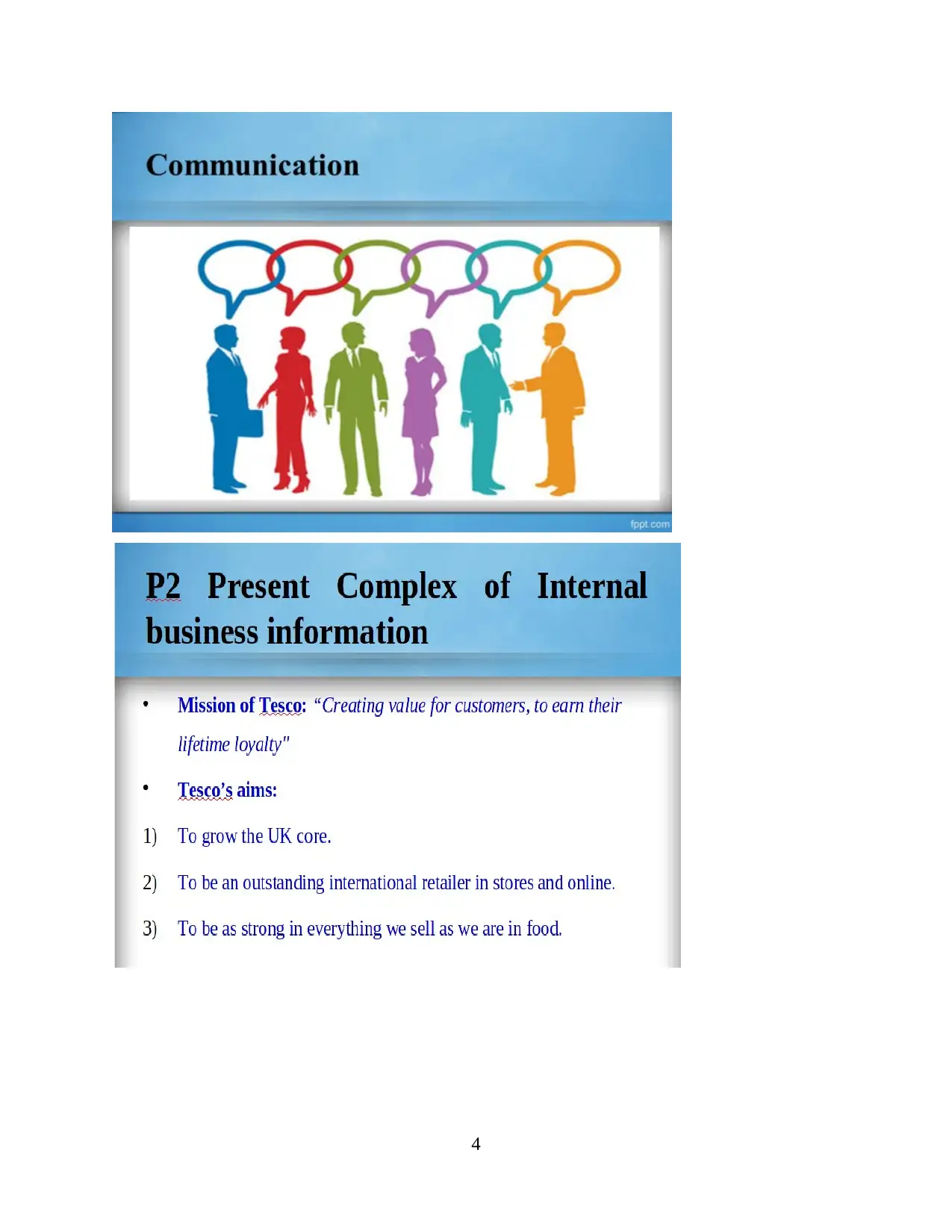
4
⊘ This is a preview!⊘
Do you want full access?
Subscribe today to unlock all pages.

Trusted by 1+ million students worldwide
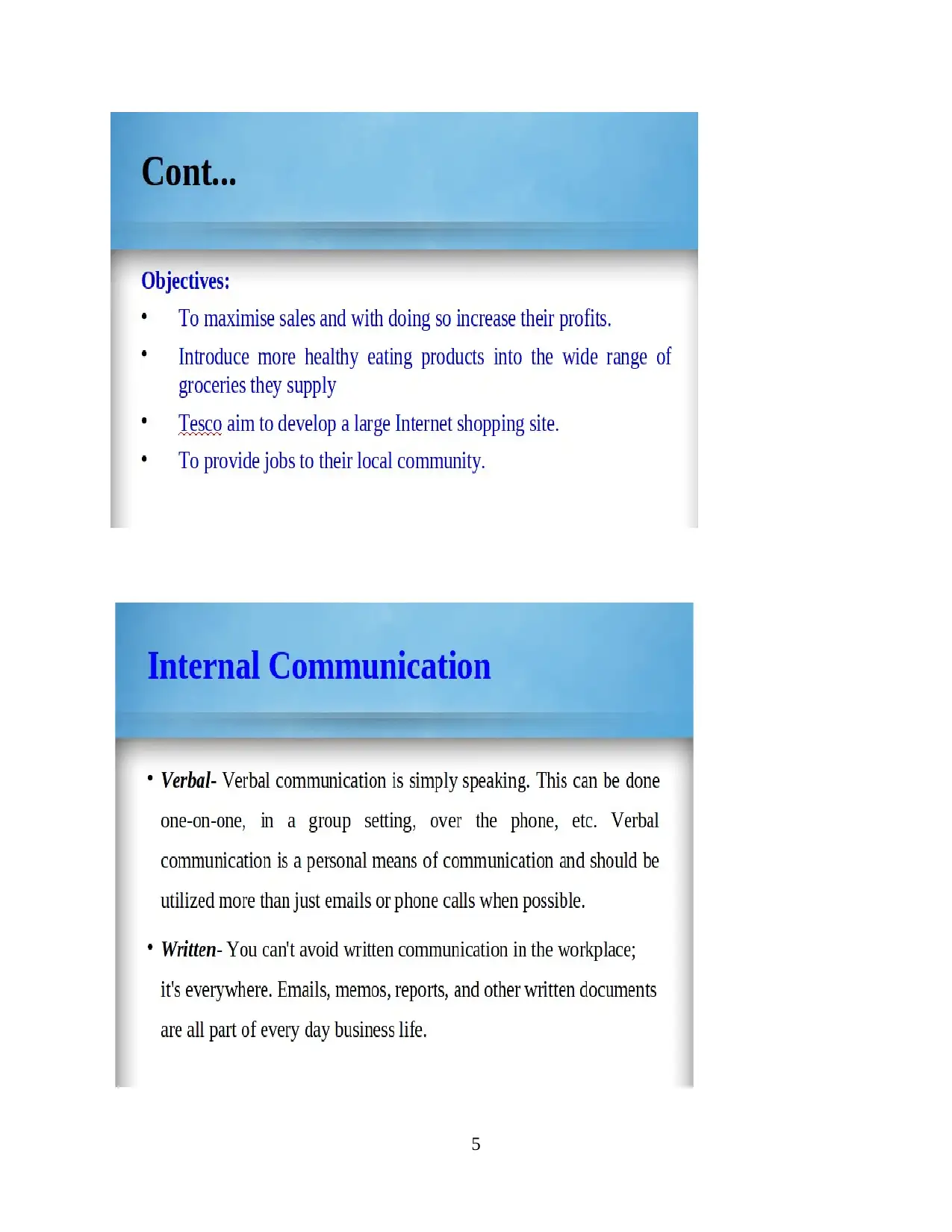
5
Paraphrase This Document
Need a fresh take? Get an instant paraphrase of this document with our AI Paraphraser
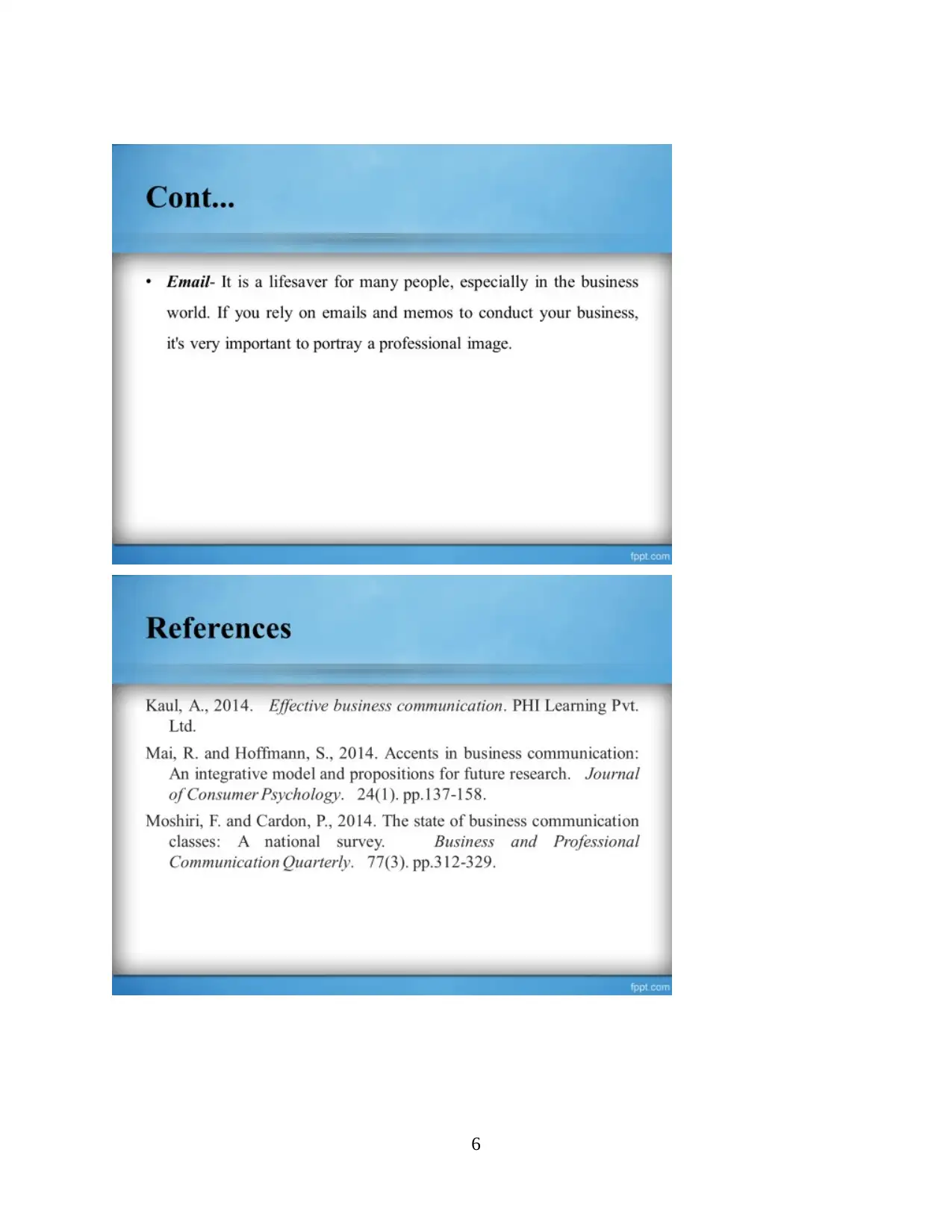
6
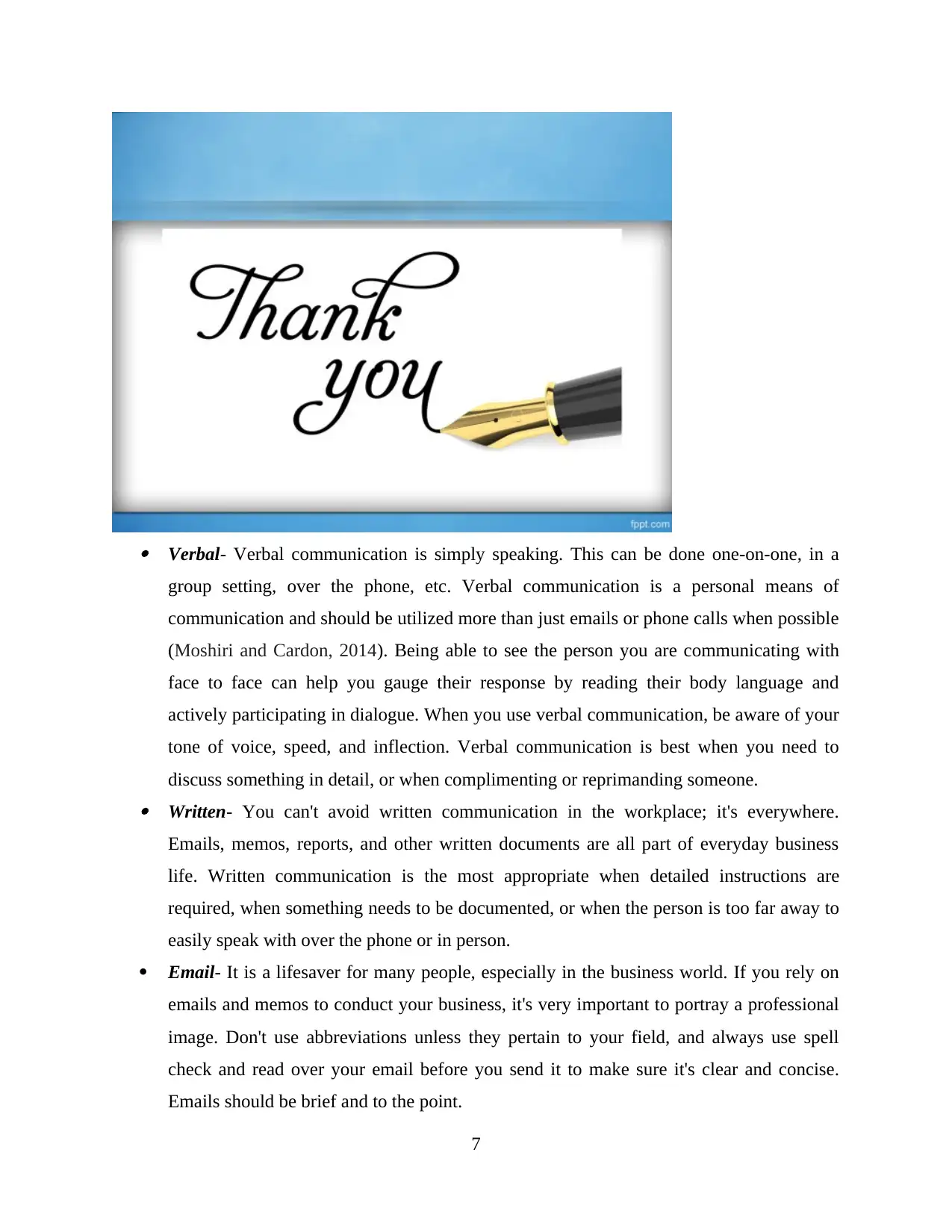
Verbal- Verbal communication is simply speaking. This can be done one-on-one, in a
group setting, over the phone, etc. Verbal communication is a personal means of
communication and should be utilized more than just emails or phone calls when possible
(Moshiri and Cardon, 2014). Being able to see the person you are communicating with
face to face can help you gauge their response by reading their body language and
actively participating in dialogue. When you use verbal communication, be aware of your
tone of voice, speed, and inflection. Verbal communication is best when you need to
discuss something in detail, or when complimenting or reprimanding someone. Written- You can't avoid written communication in the workplace; it's everywhere.
Emails, memos, reports, and other written documents are all part of everyday business
life. Written communication is the most appropriate when detailed instructions are
required, when something needs to be documented, or when the person is too far away to
easily speak with over the phone or in person.
Email- It is a lifesaver for many people, especially in the business world. If you rely on
emails and memos to conduct your business, it's very important to portray a professional
image. Don't use abbreviations unless they pertain to your field, and always use spell
check and read over your email before you send it to make sure it's clear and concise.
Emails should be brief and to the point.
7
group setting, over the phone, etc. Verbal communication is a personal means of
communication and should be utilized more than just emails or phone calls when possible
(Moshiri and Cardon, 2014). Being able to see the person you are communicating with
face to face can help you gauge their response by reading their body language and
actively participating in dialogue. When you use verbal communication, be aware of your
tone of voice, speed, and inflection. Verbal communication is best when you need to
discuss something in detail, or when complimenting or reprimanding someone. Written- You can't avoid written communication in the workplace; it's everywhere.
Emails, memos, reports, and other written documents are all part of everyday business
life. Written communication is the most appropriate when detailed instructions are
required, when something needs to be documented, or when the person is too far away to
easily speak with over the phone or in person.
Email- It is a lifesaver for many people, especially in the business world. If you rely on
emails and memos to conduct your business, it's very important to portray a professional
image. Don't use abbreviations unless they pertain to your field, and always use spell
check and read over your email before you send it to make sure it's clear and concise.
Emails should be brief and to the point.
7
⊘ This is a preview!⊘
Do you want full access?
Subscribe today to unlock all pages.

Trusted by 1+ million students worldwide
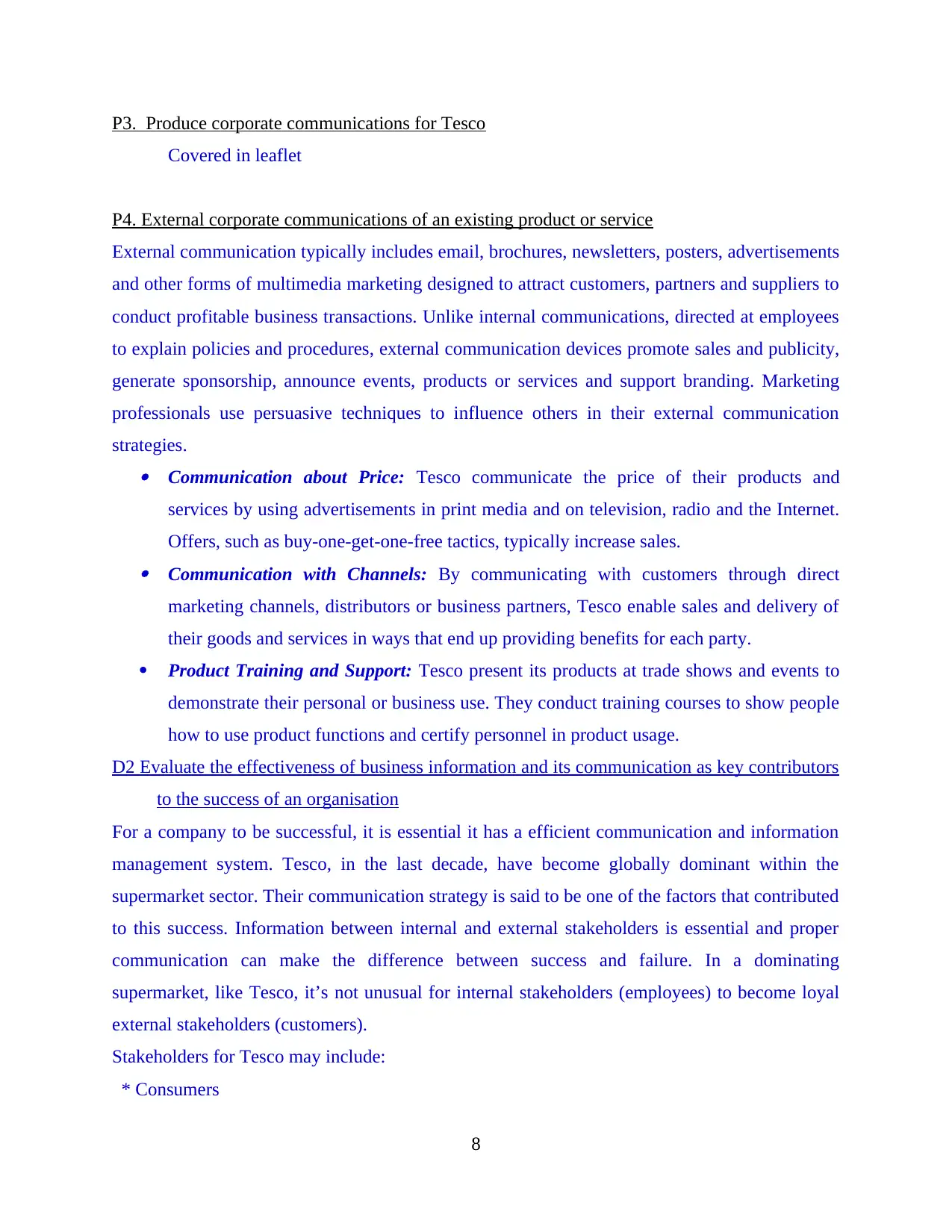
P3. Produce corporate communications for Tesco
Covered in leaflet
P4. External corporate communications of an existing product or service
External communication typically includes email, brochures, newsletters, posters, advertisements
and other forms of multimedia marketing designed to attract customers, partners and suppliers to
conduct profitable business transactions. Unlike internal communications, directed at employees
to explain policies and procedures, external communication devices promote sales and publicity,
generate sponsorship, announce events, products or services and support branding. Marketing
professionals use persuasive techniques to influence others in their external communication
strategies. Communication about Price: Tesco communicate the price of their products and
services by using advertisements in print media and on television, radio and the Internet.
Offers, such as buy-one-get-one-free tactics, typically increase sales. Communication with Channels: By communicating with customers through direct
marketing channels, distributors or business partners, Tesco enable sales and delivery of
their goods and services in ways that end up providing benefits for each party.
Product Training and Support: Tesco present its products at trade shows and events to
demonstrate their personal or business use. They conduct training courses to show people
how to use product functions and certify personnel in product usage.
D2 Evaluate the effectiveness of business information and its communication as key contributors
to the success of an organisation
For a company to be successful, it is essential it has a efficient communication and information
management system. Tesco, in the last decade, have become globally dominant within the
supermarket sector. Their communication strategy is said to be one of the factors that contributed
to this success. Information between internal and external stakeholders is essential and proper
communication can make the difference between success and failure. In a dominating
supermarket, like Tesco, it’s not unusual for internal stakeholders (employees) to become loyal
external stakeholders (customers).
Stakeholders for Tesco may include:
* Consumers
8
Covered in leaflet
P4. External corporate communications of an existing product or service
External communication typically includes email, brochures, newsletters, posters, advertisements
and other forms of multimedia marketing designed to attract customers, partners and suppliers to
conduct profitable business transactions. Unlike internal communications, directed at employees
to explain policies and procedures, external communication devices promote sales and publicity,
generate sponsorship, announce events, products or services and support branding. Marketing
professionals use persuasive techniques to influence others in their external communication
strategies. Communication about Price: Tesco communicate the price of their products and
services by using advertisements in print media and on television, radio and the Internet.
Offers, such as buy-one-get-one-free tactics, typically increase sales. Communication with Channels: By communicating with customers through direct
marketing channels, distributors or business partners, Tesco enable sales and delivery of
their goods and services in ways that end up providing benefits for each party.
Product Training and Support: Tesco present its products at trade shows and events to
demonstrate their personal or business use. They conduct training courses to show people
how to use product functions and certify personnel in product usage.
D2 Evaluate the effectiveness of business information and its communication as key contributors
to the success of an organisation
For a company to be successful, it is essential it has a efficient communication and information
management system. Tesco, in the last decade, have become globally dominant within the
supermarket sector. Their communication strategy is said to be one of the factors that contributed
to this success. Information between internal and external stakeholders is essential and proper
communication can make the difference between success and failure. In a dominating
supermarket, like Tesco, it’s not unusual for internal stakeholders (employees) to become loyal
external stakeholders (customers).
Stakeholders for Tesco may include:
* Consumers
8
Paraphrase This Document
Need a fresh take? Get an instant paraphrase of this document with our AI Paraphraser
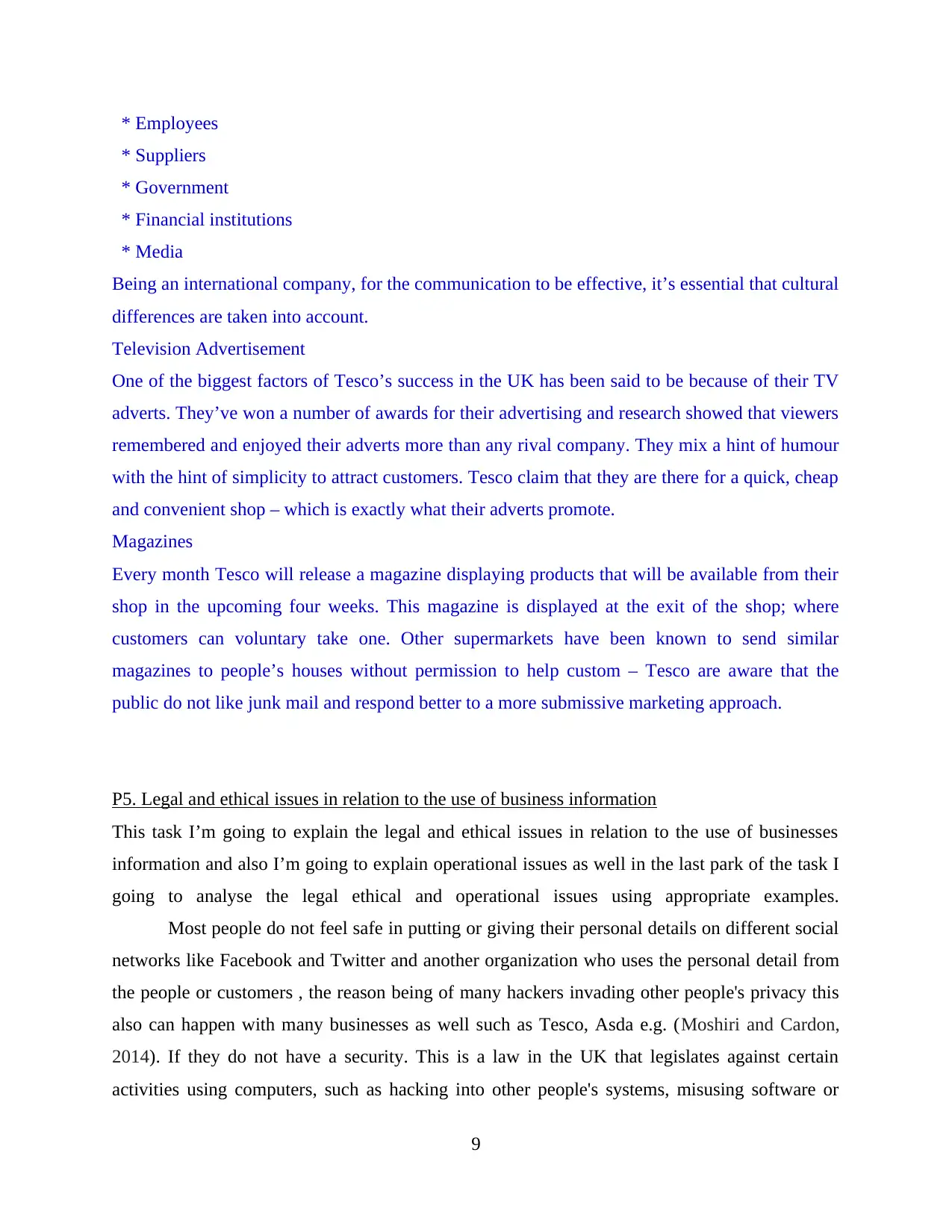
* Employees
* Suppliers
* Government
* Financial institutions
* Media
Being an international company, for the communication to be effective, it’s essential that cultural
differences are taken into account.
Television Advertisement
One of the biggest factors of Tesco’s success in the UK has been said to be because of their TV
adverts. They’ve won a number of awards for their advertising and research showed that viewers
remembered and enjoyed their adverts more than any rival company. They mix a hint of humour
with the hint of simplicity to attract customers. Tesco claim that they are there for a quick, cheap
and convenient shop – which is exactly what their adverts promote.
Magazines
Every month Tesco will release a magazine displaying products that will be available from their
shop in the upcoming four weeks. This magazine is displayed at the exit of the shop; where
customers can voluntary take one. Other supermarkets have been known to send similar
magazines to people’s houses without permission to help custom – Tesco are aware that the
public do not like junk mail and respond better to a more submissive marketing approach.
P5. Legal and ethical issues in relation to the use of business information
This task I’m going to explain the legal and ethical issues in relation to the use of businesses
information and also I’m going to explain operational issues as well in the last park of the task I
going to analyse the legal ethical and operational issues using appropriate examples.
Most people do not feel safe in putting or giving their personal details on different social
networks like Facebook and Twitter and another organization who uses the personal detail from
the people or customers , the reason being of many hackers invading other people's privacy this
also can happen with many businesses as well such as Tesco, Asda e.g. (Moshiri and Cardon,
2014). If they do not have a security. This is a law in the UK that legislates against certain
activities using computers, such as hacking into other people's systems, misusing software or
9
* Suppliers
* Government
* Financial institutions
* Media
Being an international company, for the communication to be effective, it’s essential that cultural
differences are taken into account.
Television Advertisement
One of the biggest factors of Tesco’s success in the UK has been said to be because of their TV
adverts. They’ve won a number of awards for their advertising and research showed that viewers
remembered and enjoyed their adverts more than any rival company. They mix a hint of humour
with the hint of simplicity to attract customers. Tesco claim that they are there for a quick, cheap
and convenient shop – which is exactly what their adverts promote.
Magazines
Every month Tesco will release a magazine displaying products that will be available from their
shop in the upcoming four weeks. This magazine is displayed at the exit of the shop; where
customers can voluntary take one. Other supermarkets have been known to send similar
magazines to people’s houses without permission to help custom – Tesco are aware that the
public do not like junk mail and respond better to a more submissive marketing approach.
P5. Legal and ethical issues in relation to the use of business information
This task I’m going to explain the legal and ethical issues in relation to the use of businesses
information and also I’m going to explain operational issues as well in the last park of the task I
going to analyse the legal ethical and operational issues using appropriate examples.
Most people do not feel safe in putting or giving their personal details on different social
networks like Facebook and Twitter and another organization who uses the personal detail from
the people or customers , the reason being of many hackers invading other people's privacy this
also can happen with many businesses as well such as Tesco, Asda e.g. (Moshiri and Cardon,
2014). If they do not have a security. This is a law in the UK that legislates against certain
activities using computers, such as hacking into other people's systems, misusing software or
9
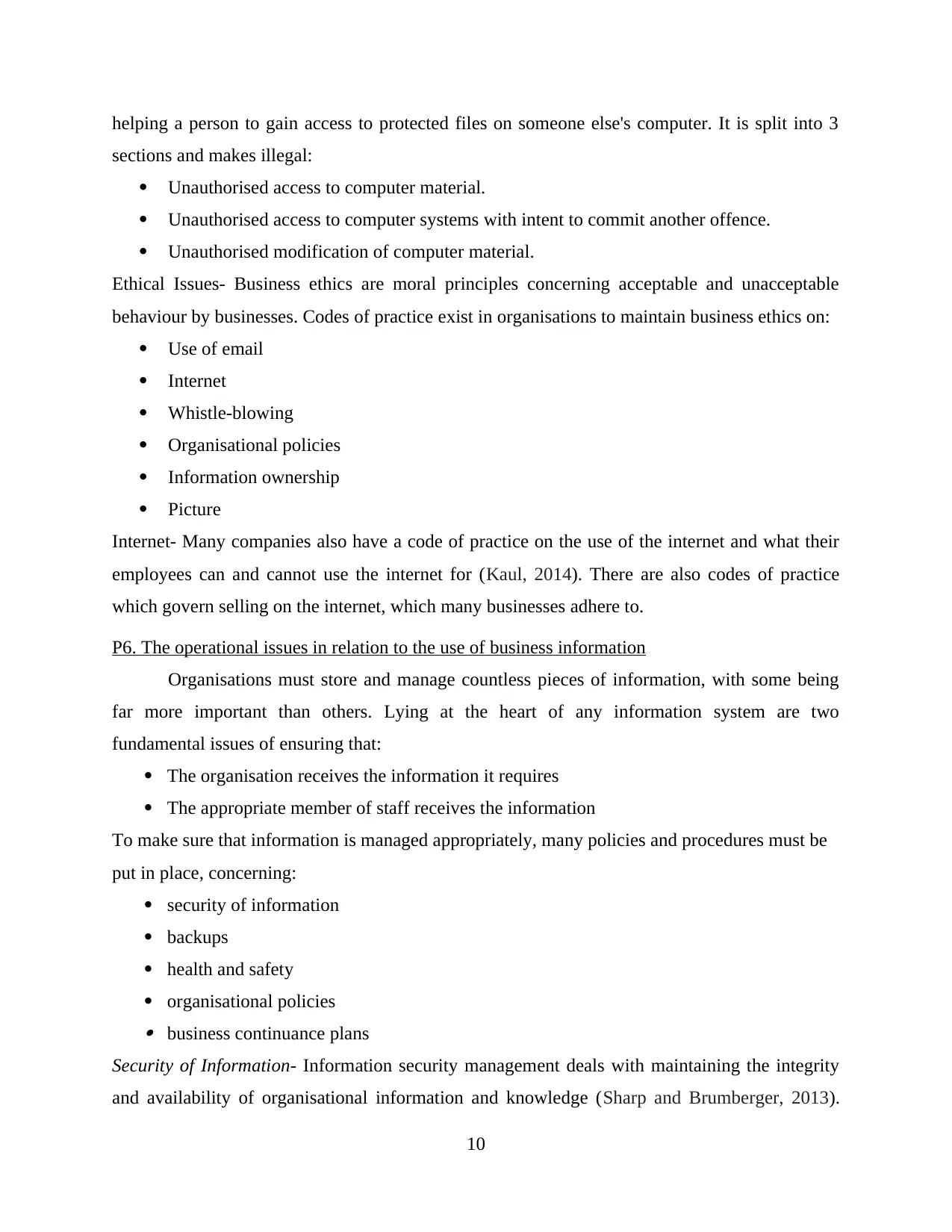
helping a person to gain access to protected files on someone else's computer. It is split into 3
sections and makes illegal:
Unauthorised access to computer material.
Unauthorised access to computer systems with intent to commit another offence.
Unauthorised modification of computer material.
Ethical Issues- Business ethics are moral principles concerning acceptable and unacceptable
behaviour by businesses. Codes of practice exist in organisations to maintain business ethics on:
Use of email
Internet
Whistle-blowing
Organisational policies
Information ownership
Picture
Internet- Many companies also have a code of practice on the use of the internet and what their
employees can and cannot use the internet for (Kaul, 2014). There are also codes of practice
which govern selling on the internet, which many businesses adhere to.
P6. The operational issues in relation to the use of business information
Organisations must store and manage countless pieces of information, with some being
far more important than others. Lying at the heart of any information system are two
fundamental issues of ensuring that:
The organisation receives the information it requires
The appropriate member of staff receives the information
To make sure that information is managed appropriately, many policies and procedures must be
put in place, concerning:
security of information
backups
health and safety
organisational policies business continuance plans
Security of Information- Information security management deals with maintaining the integrity
and availability of organisational information and knowledge (Sharp and Brumberger, 2013).
10
sections and makes illegal:
Unauthorised access to computer material.
Unauthorised access to computer systems with intent to commit another offence.
Unauthorised modification of computer material.
Ethical Issues- Business ethics are moral principles concerning acceptable and unacceptable
behaviour by businesses. Codes of practice exist in organisations to maintain business ethics on:
Use of email
Internet
Whistle-blowing
Organisational policies
Information ownership
Picture
Internet- Many companies also have a code of practice on the use of the internet and what their
employees can and cannot use the internet for (Kaul, 2014). There are also codes of practice
which govern selling on the internet, which many businesses adhere to.
P6. The operational issues in relation to the use of business information
Organisations must store and manage countless pieces of information, with some being
far more important than others. Lying at the heart of any information system are two
fundamental issues of ensuring that:
The organisation receives the information it requires
The appropriate member of staff receives the information
To make sure that information is managed appropriately, many policies and procedures must be
put in place, concerning:
security of information
backups
health and safety
organisational policies business continuance plans
Security of Information- Information security management deals with maintaining the integrity
and availability of organisational information and knowledge (Sharp and Brumberger, 2013).
10
⊘ This is a preview!⊘
Do you want full access?
Subscribe today to unlock all pages.

Trusted by 1+ million students worldwide
1 out of 16
Related Documents
Your All-in-One AI-Powered Toolkit for Academic Success.
+13062052269
info@desklib.com
Available 24*7 on WhatsApp / Email
![[object Object]](/_next/static/media/star-bottom.7253800d.svg)
Unlock your academic potential
Copyright © 2020–2025 A2Z Services. All Rights Reserved. Developed and managed by ZUCOL.





